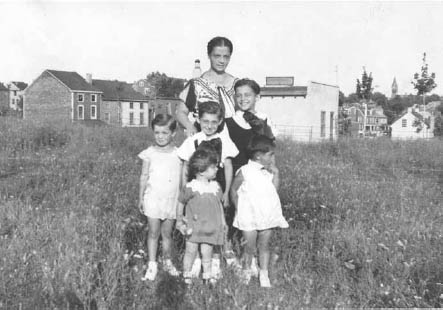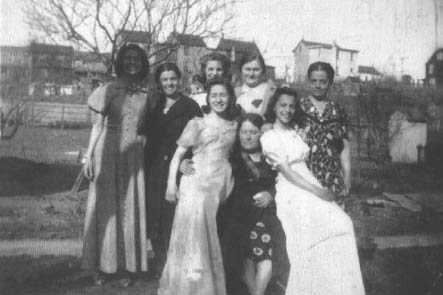Remembering Conshohocken and West Conshohocken (4 page)
Read Remembering Conshohocken and West Conshohocken Online
Authors: Jack Coll

Hector's obituary in the
Norristown Register
was really quite an honor in that newspapers at that time didn't post obituaries for members of the African American community.
Hector was buried in Upper Merion Township. His wife, Jude, died on the way home from the burial. Hector had applied to Congress three times for his pension over the years after the war, and at the age of eighty-nine, a year before he died, he received a token payment of forty dollars.
In 1853, three years after the borough of Conshohocken incorporated and nineteen years after Hector's death, borough council, led by Burgess John Wood, passed a measure to rename Barren Hill Road from Fayette Street to North Lane in honor of Edward “Ned” Hector. Many of the councilmen in 1853 had known Ned personally and felt honored to rename Barren Hill Road “Hector Street.”
A historical marker furnished by the Pennsylvania Museum and Historical Commission was dedicated on September 19, 1976, honoring Hector. The marker sits at the northeast corner of what are now West Hector and Fayette Streets. The marker is located less than one hundred yards from the site of Hector's cabin, later demolished to make way for St. Matthew's first church.
The iron marker reads: “Private in Captain Hercules Courtney's Company, Third Pa. Artillery Continental Line, in the Battle of Brandywine. His home was in Conshohocken. He is symbolic of the many unknown Black soldiers who served in the American Revolution, but whose race is not mentioned in muster rolls.”
ARLY
L
EADERS AND
S
TREET
N
AMES
Conshohocken's streets were named after prominent early settlers of the borough. The five men involved in the incorporation proceedings all had streets named after them or their families. James Wood, ironmaster, known as the “Father of Conshohocken,” and his son James, who was the borough's first burgess and later elected a United States congressman, were honored with the naming of
Wood Street
.
David Harry, who purchased 1,250 acres of ground from Jasper Farmer in 1700, was remembered on the entire east side of the borough. Harry's grandson, also named David, was involved in the incorporation, and for many years the Harry family served in prominent positions in the borough, hence the name
Harry Street
.
David Jones purchased 160 acres from the Harry family in 1754. Isaac Jones, a descendant of David, was a farmer and businessman and the borough's third incorporator. Isaac was also the president of the Matsonford Bridge Company for many years. The Jones family had very deep roots in the village and later the borough, so it made sense that the borough would have a
Jones Street
.
Wells Street
was named after James Wells, who also was a signer of the incorporation papers. Wells owned and operated the Ford Hotel and Train Depot located alongside the river and canal. The fifth signer of incorporation was Cadwallader Foulke, a member of the Plymouth Meeting Friends Society. Foulke owned and operated a farm in the Connaughtown section of the borough, where
Foulke Street
was located.
William Hallowell was a member of the borough's first council in 1850 and later served as the borough's burgess in 1856 and again from 1862 to 1864. Hallowell built his handsome Victorian home on the corner of West Seventh Avenue and Forest Street; the building still stands today as an apartment house, but for some odd reason
Hallowell Street
is located on the east side of the borough. Hallowell was in the construction business and built Conshohocken's Baptist Presbyterian Church and the Patriotic Order Sons of America Building located at Second Avenue and Fayette Street (the current location of Tony & Joe's Pizzeria), among other prominent buildings of the day.
John Righter married Elizabeth Legaux, a descendant of Peter Legaux. Righter owned a good portion of the Legaux property located in the Spring Mill section of the borough and, in 1909, sold twenty-three acres to John Elwood Lee.
Righter Street
runs behind what would become Lee Tire and Rubber Company of Conshohocken.
Stephen Colwell had his iron and lime business throughout the Conshohocken and Plymouth area and conducted a portion of his business with the J. Wood & Sons Company. Colwell would smelt his iron into ingots and transport them along a dirt path that he cut through the woods on the lower west side of the borough. Because of the location of the trail, often Colwell's horses and wagons were the only travelers to be found on the trail, a trail that became known as Colwell's Lane. The name never changed, and even when the more modern highways pushed through the name remained
Colwell Lane
. It wasn't until 1966, under the pressure of the Conshohocken Chamber of Commerce led by George Gunning, that the borough opened up the lower half of Colwell Lane to traffic.
Members of the Forrest family were early business leaders in the borough and built two large buildings on Marble Street and what later would become
Forrest Street
. One of the buildings was the Forrest Hotel. Members of the family were sensitive to the borough's needs and often supported them in times of need.
John Freedley had limekilns located along the banks of the Plymouth Creek between Ridge and Germantown Pike. Dr. Freedley lived in an area known as Ivory Rock, and his house was later used by the Alan Wood Steel Company as offices. The name
Freedley Street
appears on area maps dating back to 1848, two years before the borough's incorporation.
Sutcliffe Lane
sits at the base of Sutcliffe Park, developed in the early 1960s. Sutcliffe Lane sits on a former dairy farm. In 1929, Frank Sutcliffe was president of the former John Wood Manufacturing Company and president of a realty firm that developed most of the upper portion of the borough. Sutcliffe donated thirty-nine acres of land to be used as a park in honor of his wife, Mary Jane.
As a side note, street names on the lower east side named after trees, like
Walnut, Cherry, Poplar, Elm, Ash
and
Apple
Streets, came as a result of David Harry's nursery once being located throughout the lower half of the borough. The streets were properly named after the trees once grown on the site.
Spring Mill Avenue
was named because it was the road that led to Bubbling Springs, once located in the Spring Mill section of the borough.
As stated earlier,
Hector Street
was named after Edward “Ned” Hector,
Washington Street was
named after General George Washington and
Fayette Street
was named after General Gilbert du Motier, Marquis de Lafayette.
VERYBODY
'
S
W
ELCOME
, T
HEY
C
AME
L
OOKING FOR
A
MERICA
When the borough incorporated in 1850, Conshohocken had 727 residents. By 1860, the population had grown to 1,741 residents. In 1870, the population had jumped to 3,071, and nearly six hundred houses dotted the landscape. Although there were only three farms within the borough limits, there were twenty-eight different places of industry, and industry equaled immigrant opportunity.
In the 1820s, many Irish settlers found work with the Schuylkill Navigation Company, which began work in 1816 on a 108-mile stretch of canal beginning in Port Carbon and running through five counties, including the borough of Conshohocken. Many of these Irish immigrants settled in the Norristown area. By the mid-1830s, the Irish had begun construction of St. Patrick's Catholic Church in Norristown, the first Catholic church in Montgomery County.

Members of the Cianelli family gathered on the front porch of their West Second Avenue Home in 1923 for this group photograph. Teresa Cianelli is seated on the steps, second from left in the front row. Teresa's mother, Clara, is seated in the center of the row dressed in black, and Dominick is on the far right, standing. It wasn't uncommon for immigrants to come to this country and live with relatives until they found jobs in the mills.
Courtesy of Theresa Manley
.
In 1841 and again in 1847, thousands of Irish immigrants poured into Montgomery County to escape from the destitution in Ireland when droughts ruined the potato fields, leading to family evictions. The need to survive sent them to America. From 1820 to 1850, more than four million Irish fled their native land to look for the American dream, and many of them found it in Conshohocken. By 1880, 78 percent of Conshohocken's population was foreign-born, and these immigrants found jobs as laborers and later owned land in Conshohocken.
According to the 1870 census, approximately 25 percent of Conshohocken's 3,071 residents were born in Ireland. Many Irish found work building the first railroads along the Schuylkill River and working in the many Conshohocken mills. By 1856, the Conshohocken Irish had built St. Matthew's Roman Catholic Church at the corner of Hector and Harry Streets.

Ilde Manetti poses with her five children in 1934 in the “Field of Daises,” once located at the far end of West Third Avenue behind the bocce club, seen in the background. Ilda's five children are Gloria and Vilma in the front row and Ruth, Louis and Marie in the back row.
Courtesy of Vilma Manetti Frattone
.
By 1900, Irish residents made up most of the town's population, many of them opening businesses along the ninety-foot-wide dirt road called Fayette Street. In 2009, residents of Irish descent made up more than 25 percent of Conshohocken's population, making it the largest ethnic group of residents in the borough.
From 1880 to 1900, immigrants began arriving from Poland looking for the same work that would allow them to become landowners, as the Irish had before them. According to the 1880 census, a number of Polish immigrants arrived and lived along the Schuylkill River in Upper Merion Township, including Swedeland. With jobs available in the many stone quarries and woolen mills, the Polish immigrants expanded into Bridgeport and Conshohocken, where women and children also found jobs.
By 1905, Conshohocken was the first town in Montgomery County to support a Catholic church strictly for Polish immigrants. St. Mary's Church was founded in 1905, followed by Sacred Heart Church in Swedesburg, founded in 1906. The founding of St. Mary's Church led to many Polish-owned business in the area of West Elm and Maple Streets. By 1980, one-third of the borough's residents were of Polish descent. According to the latest census, Polish residents currently make up 13 percent of the borough's population.

In 1938, a group of West Third Avenue residents gathered for a block photograph. From left to right, the four ladies standing in the back include Jeannie Cardamone, Frankina Agustinelli, Lucky Androni and Mrs Androni. In the front row from left were Angie Santoni, Mrs. Santoni, Marie Manetti and her mother, Ilda Manetti. The back of West Fourth Avenue can be seen in the background; notice the outhouse on the right. Outhouses were very commonplace into the 1950s in Conshohocken.
Courtesy of Vilma Manetti Frattone
.
